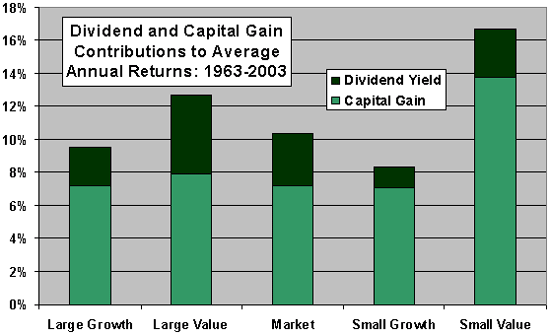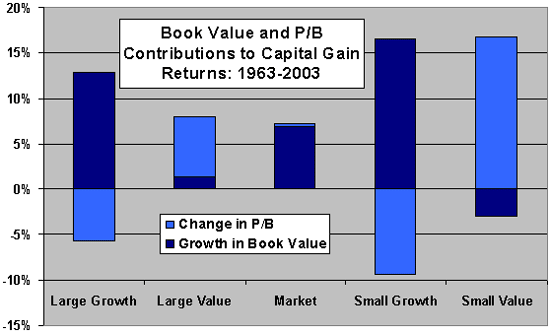In the September 2005 version of their paper entitled “The Anatomy of Value and Growth Stock Returns”, Eugene Fama and Kenneth French separate the average returns on both value and growth portfolios into dividends and three sources of capital gains: (1) reinvestment of earnings (growth in book value); (2) change in price-to-book ratios (P/B) due to mean reversion in profitability, and (3) a secular upward drift in P/B. Using data spanning 1926-2003 for NYSE, AMEX and NASDAQ stocks, they find that:
- Value stocks have on average outperformed growth stocks, and small capitalization value stocks have outperformed large capitalization value stocks.
- Capital gains of value stocks come mostly from P/B expansion as some value firms become more profitable.
- For growth stocks, P/B tends to fall because not all growth companies remain highly profitable. Reinvestment of earnings produces most of the capital gains for growth stocks.
- On average, driven by market forces, extreme values of P/B tend to moderate due to mean reversion of profitability.
- P/B has slowly risen over 1926-2003, contributing only about 1% of annual returns for all categories of stocks. However, the contribution to volatility of this drift is large compared to the contributions of dividends, book value and P/B reversion.
The authors offer both rational and behavioral explanations for P/B mean reversion.
The following chart depicts the contributions of dividends and capital gains to average compounded annual returns for the stock market overall and for several categories of stocks, addressing only the 1963-2003 sub-period included in the paper.
The next chart shows contributions to capital gain returns of changes in book value and changes in P/B for the same period and the same categories of stocks. It shows that reinvestment of earnings tends to drive capital gains for growth stocks, and a change (an increase) in P/B tends to drive capital gains for value stocks. The chart shows that, in fact, P/B tends to fall for growth stocks.
In summary, because mean reversion of price-to-book ratios outpaces reinvestment of earnings, value stocks outperform growth stocks

